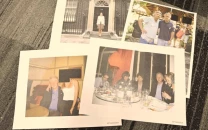Jeepneys go far beyond the call of duty
Unlike Pakistan’s traditional truck art, Filipino jeepney art is influenced by foreign pop culture.
Jeepneys go far beyond the call of duty
Swerving past you through Manila’s crowded roads are canvases on wheels called Jeepneys that offer cheap public transport as well as a unique creative expression to Filipino street art. Jeepneys are an interesting amalgamation of a jeep and a truck that Filipinos devised from the war vehicles left behind by the Americans as they fled the island after World War II.
Flamboyant and multihued in a palette that ranges from candy-floss pink and violet to sunshine-yellow and powder-blue, jeepneys are by far the cheapest, most popular and most flashy set of wheels to dominate Manila’s teeming paths.
As a Pakistani, your first instinct is ‘Hey, they copied our truck art’. But on a deeper introspection, it’s remarkable how traditions and customs permeate and are recreated in other forms across different cultures. The loud images, the neon paint and the graphics illustrate contemporary Filipino lifestyle in the same way as Pakistan’s trucks pick up on indigenous imagery, slogans and rural motifs. But unlike Pakistan’s truck art, which is inherently local in its content, Filipino jeepney art draw on images that are influenced by foreign pop culture like Disney fantasies, Hello Kitty and Matrix Reloaded that ironically straddle Catholicism and potent images of Virgin Mary and Christ along with those of superheroes and the Grand Slam.
Depending on the route, the jeepneys take on different avatars. In Cubao, a locale studded with malls, these vehicles take on a whole new avatar: Disco on wheels. Red lights within the vehicle, popular dance and pop music blaring through the speakers and a Lenny Kravitz-inspired driver grooving to the music and the traffic simultaneously, are a common sight here. At the University of the Philippines route, the jeepneys are bland and sedate in keeping with the university policy for seriousness of purpose. Only the roofs are coloured in red, yellow and green with each colour representing a certain route that the vehicle follows.
Ranie Sevilla has been driving for 10 years, but doesn’t have enough money to buy his own jeepney which costs a whopping 400,000 pesos. “My jeepney is rather bare since I bought it second hand as it is. If I had to design it, I would put a picture of Jesus and some writings from the Bible along with names of my family as a reminder that I am doing this every day for them,” says Sevilla. Most jeepneys, even those with cinematic or racing car images, have some Biblical motif, painted to denote how deeply religious Filipino society is.
Nelson, driver and owner of a jeepney whose vehicle takes the arduous route from the metro to its outskirts, explains that initially it was all about painting the body of his vehicle creatively, but later it was about installing red and blue lights inside along with a loud music system. His own jeepney boasts of a karaoke onboard. “The ride from the city to Rizal (a neighbouring province) is a long one. Hence, to entertain our passengers we have installed a karaoke system,” he says. So apart from the cacophony of the traffic, one will have to bear the discordance of fellow commuters’ croaking voices. Contrary to what one might believe, this service is imparted free of cost to passengers onboard.
The current trend to hit jeepneys is laptops, informs Nelson whose other vehicle has gone for refurbishment and will carry a laptop on board. Given how well equipped Manila is in terms of wifi, it isn’t hard to imagine that the next generation of jeepneys will carry laptops. From a canvas to a discotheque to a karaoake car to an internet cafe on wheels now, one wonders what the next destination for Manila jeepneys.
Published in The Express Tribune, July 12th, 2011.



















COMMENTS
Comments are moderated and generally will be posted if they are on-topic and not abusive.
For more information, please see our Comments FAQ